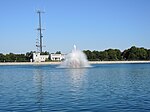Edward E. Boynton House

The Edward E. Boynton House (1908) was designed by Frank Lloyd Wright in Rochester, New York. This privately owned prairie-style home was commissioned by widower Edward Everett Boynton and his teenage daughter Beulah Boynton. According to Beulah Boynton (recounted to Times Union reporter William Ringle in 1955) it cost her father between $45,000 - $50,000 for the house, the lot and the contents - a staggering sum in 1908 (adjusted for inflation, approx. $10 million in 2021). This two-story, approximately 5,500 square foot home, was originally situated on an acre lot in the city of Rochester. Seventeen pieces of original Frank Lloyd Wright furniture remain in the house.
Excerpt from the Wikipedia article Edward E. Boynton House (License: CC BY-SA 3.0, Authors, Images).Edward E. Boynton House
East Boulevard, City of Rochester
Geographical coordinates (GPS) Address Nearby Places Show on map
Geographical coordinates (GPS)
| Latitude | Longitude |
|---|---|
| N 43.146575 ° | E -77.569275 ° |
Address
East Boulevard 16
14610 City of Rochester
New York, United States
Open on Google Maps




